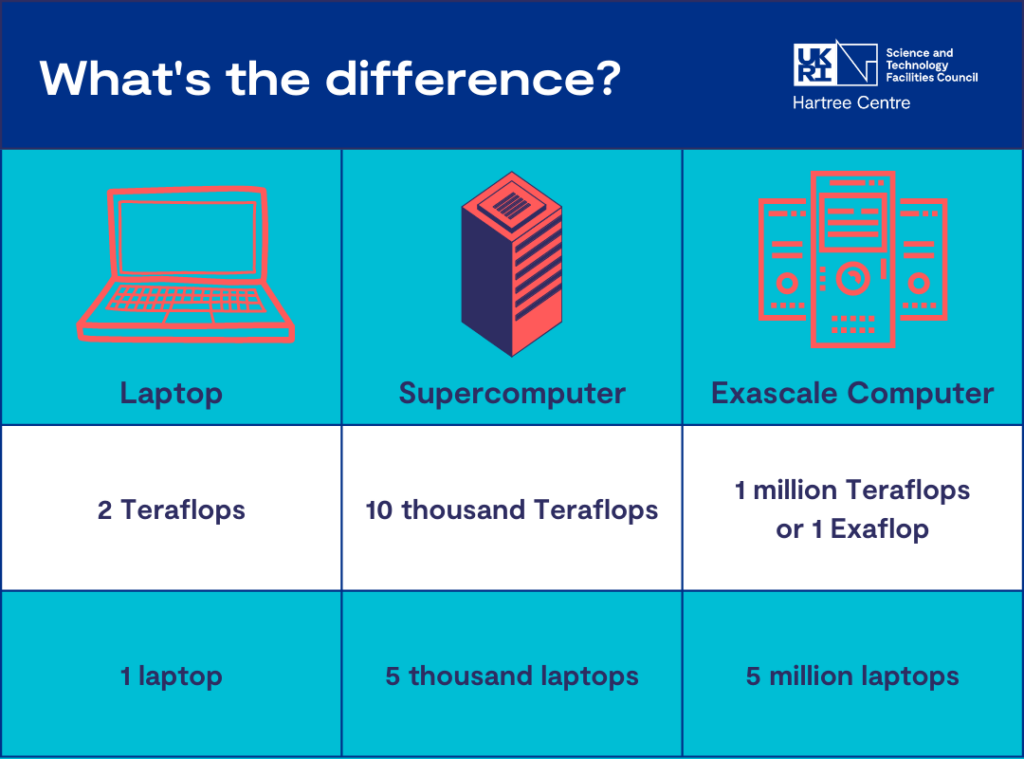Is the UK ready for exascale computing?
What does the dawn of exascale computing mean for the UK, and how will this change UK industry? Find out what our Director Katherine Royse has to say on the matter.

Exascale computing is now a reality. Referring to computers that can perform more than 1*1018 calculations a second – or 1 exaflop – exascale computers are comparable to the estimated processing power of the human brain. The world’s first exascale computer, was created in the USA with Frontier in June 2022, and the first European exascale supercomputer, JUPITER, will be installed in 2023.
Until now, there have been many problems which have been impossible or extremely difficult to solve, as they require high-precision simulation of complex systems or the intensive use of artificial intelligence (AI) to analyse large datasets. Exascale computing can be used to model this kind of complex problem, from pandemics and climate resilience to simulating new forms of energy production such as fusion. It can also be used for materials development and drug discovery – the applications are endless.

All future major scientific discoveries will, I am sure, start life ‘in-silico’, moving the initial discovery through the digital world with its advances in computational modelling, simulation, data analytics, and AI. All of which will be possible due to the exponential increase in memory, storage and compute power made possible by exascale machines.
The UK government has set a clear ambition for the country to be recognised as a global science superpower and an “innovation nation”, with science and technology central to future economic and social prosperity. Clearly, to achieve this, the UK will need to prepare academia, industry, and the public sector for the exascale revolution. This will necessitate significant long-term investment across both research and business sectors. To build this advantage, we will need to invest strategically in hardware systems, which critically should be accessible to research-intensive businesses as well as academia.
International partnerships are key in ensuring that the UK is technology ready, as we can learn a lot from collaboration with our international colleagues. Recently, I visited the Exascale Computing Project (ECP) annual meeting in the US. What I took away from ECP is that it’s essential to develop an exascale computing ecosystem within the UK. This will provide breakthrough solutions addressing global scientific challenges around energy assurance, economic competitiveness, and national security. To achieve this, we will need multiple facilities, both pre-exascale and exascale, that have different architectures and configurations to tackle the variety of these challenges. Alongside this, we will need to develop and deploy a comprehensive, vertically integrated software stack on these systems, and this will require investment in application development and software technology.

Another take home from ECP was the importance of stretching resources as much as you can by identifying the frontrunners. The US Department of Energy has invested $1.7 billion in its research and development (R&D) programme, and taken a very focused approach, concentrating on the accelerated GPU route and backing a few software technologies. Often the cost of redesigning software applications is what blocks the uptake of new technology within the research and business community. ECP has invested effort in porting scientific software where existing simulations will not perform effectively on GPU-accelerated supercomputers, thus bringing the user community with them and increasing interest from outside the core user groups.
One of the key things I was interested in at ECP was how the National Labs were working together on R&D by pooling resources across the whole community, which has sped up progress. Their goal was to be exascale ready in under a decade, with their programme coming to an end this year, I would say that they have been successful. The National Labs have provided clear user requirements relating to the facilities and missions that they deliver, which has enabled them to clearly demonstrate the technological advantage that exascale makes, meaning that the whole R&D community can benefit from it – academia, public sector and industry.
In the UK, we are taking our steps towards exascale with programmes like the UKRI-funded ExCALIBUR programme, which we are working on. Since 2021 the Hartree Centre has been collaborating on extreme-scale computing to accelerate innovation in fusion energy with our colleagues at UKAEA. Our focus at the Hartree Centre is to actively support all kinds of organisations in the use of new digital technologies such as exascale through our training programmes, workshops and collaborative R&D programmes. We are set to play a key role in the UK journey to become exascale ready, and I for one, am excited to be part of the exascale revolution.
Join Newsletter
Provide your details to receive regular updates from the STFC Hartree Centre.
